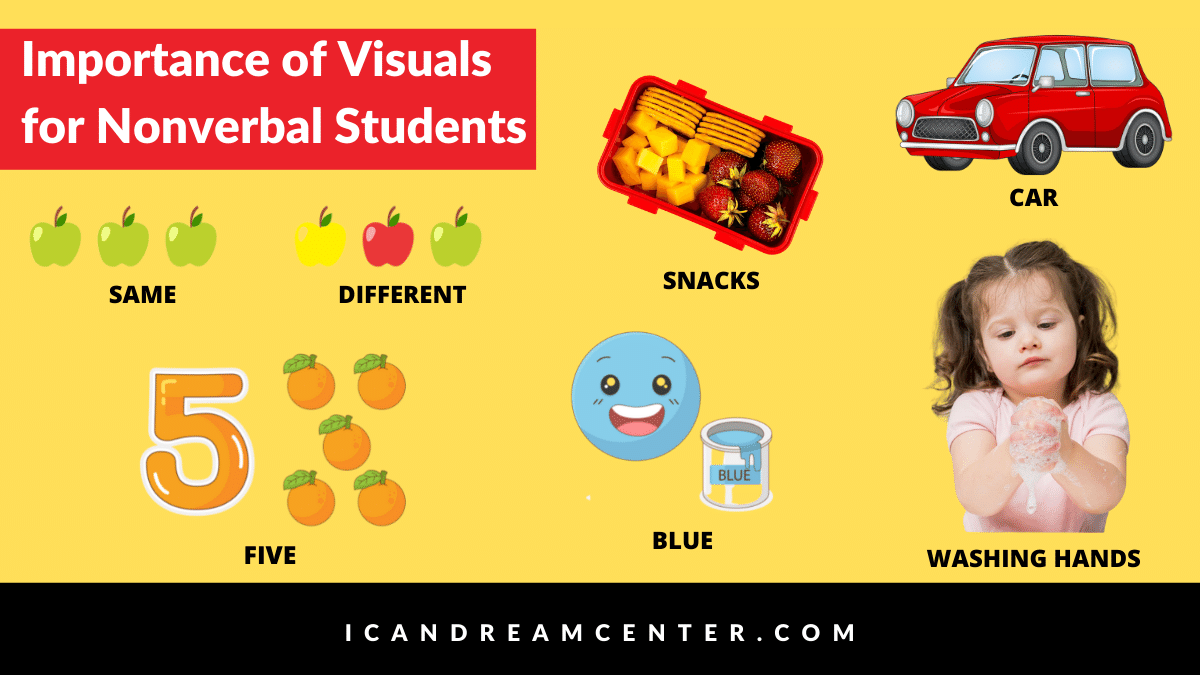
Importance of Visuals for Nonverbal Students
Why Incorporate Visuals?
Visuals are beneficial supports for children with limited verbal communication. Hodgdon (1995) proposed four reasons for using visuals within home, school, and community environments: (a) visuals increase children’s reliability (they are more likely to know what to do and then to do this repeatedly), (b) visuals encourage children to be more independent, (c) visuals provide children with structure and predictability, and (d) visuals create orderliness in the environment that then provides children with a sense of stability. In addition, researchers have shown that teachers can use visual supports to successfully assist students with autism spectrum disorder (ASD) and other disabilities who struggle with social interactions, behavioral challenges, organization, transitions from one activity to another, and communication difficulties (Meadan et al., 2011). Several types of visual support have proven effective and are typically available to young children with limited verbal language.
What Exactly are Visuals?
Visual supports may include real objects, photographs, line drawings, and words. These supports range from being very concrete (real objects) to more flexible and abstract (words and line drawings). Deciding the type of visual support to be used is dependent on the student’s specific needs. For example, some students may require photographs of the actual object or location being discussed, whereas others may be fine with line drawings. For some students, actual photographs or objects may better solidify the connection between the photo/item and the activity. Some students may not require concrete representations, and line drawings may be better suited. A few programs are available to create these line drawings (e.g., Boardmaker), and are very comprehensive in the images included. Line drawings provide greater flexibility and are typically easier to organize and incorporate. Words may also be utilized as a visual support. Words can be paired with photos and line drawings to facilitate print awareness. Including words with images can also help teachers and caregivers to use consistent language when referring to an item or location.
How are Visuals Used to Support Language?
Visual supports can be incorporated in home and classroom environments in various ways. This includes daily schedules, scripts, and communication systems. One specific example of how visual supports are used to increase language use is through the Picture Exchange Communication System (PECS). PECS is a form of alternative and augmentative communication that utilizes pictures, prompting, and reinforcement strategies to facilitate communication. PECS has been associated with language growth, and one study found that some of their participants increased their speaking and social approaching when PECS was implemented (Sulzer-Azaroff et al., 2009). Along with this, using visuals within a classroom or home environment can help children with limited verbal language function more independently and decrease their need for adult prompts when completing daily tasks. This may include pictures or other visual representations of where the next activity will take place, the steps in a specific routine (e.g., bathroom routine), or pictures of items placed where they are kept.

Overall, visual supports are a beneficial strategy that may be individualized based on the student’s communication needs. Using these types of supports is fairly nonintrusive and supports a student’s language development and independence.
References
Hodgdon, L. A. (1995). Visual strategies for improving communication. Troy, MI: QuirkRoberts
Meadan, H., Ostrosky, M. M., Triplett, B., Michna, A., & Fettig, A. (2011). Using visual supports with young children with autism spectrum disorder. Teaching exceptional children, 43(6), 28-35.
Sulzer-Azaroff, B., Hoffman, A. O., Horton, C. B., Bondy, A., & Frost, L. (2009). The Picture Exchange Communication System (PECS) What Do the Data Say?. Focus on autism and other developmental disabilities, 24(2), 89-103.
